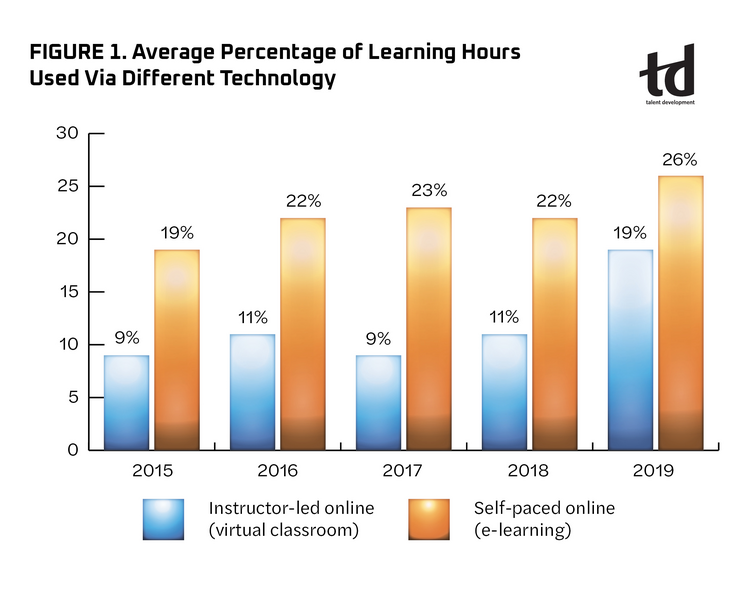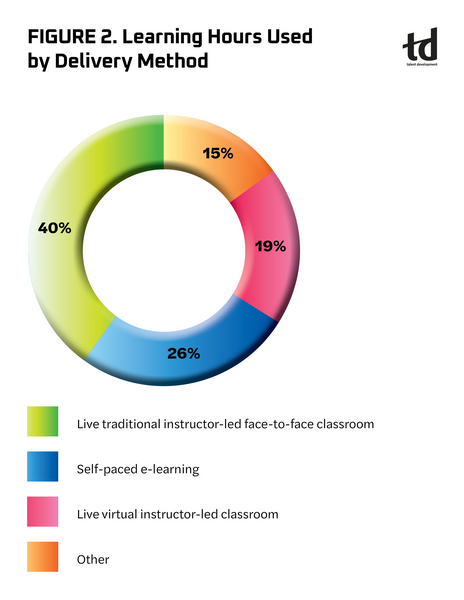TD Magazine Article
Learning Technology Is Trending Up
ATD’s latest State of the Industry report reveals an uptick in tech use in 2019 plus other TD benchmarks and trends.
Tue Dec 01 2020

ATD's latest State of the Industry report reveals an uptick in tech use in 2019 plus other TD benchmarks and trends.
The use of technology—both real-time virtual classrooms and self-paced e-learning—to deliver learning in 2019 grew at a rapid pace, according to the Association for Talent Development's 2020 State of the Industry report. That's before the COVID-19 pandemic upended in-person training this year.
The study also found that the average organization had a direct learning expenditure of $1,308 per employee in 2019. To reach those conclusions, ATD's researchers analyzed self-reported data from 283 organizations representing a wide range of industries, company sizes, and locations. AllenComm and Allego sponsored the 2020 State of the Industry report.
Technology-supported learning
At the average organization, self-paced online delivery (e-learning) accounted for 26 percent of hours used in 2019, up from 22 percent the year before. That is in line with ATD's findings in the report E-Learning: The Evolving Landscape.

It states: "Use of e-learning is rising. It currently makes up between 21 and 40 percent of the median organization's learning portfolio compared with between 1 and 20 percent five years ago. In another five years, the median organization anticipates delivering between 41 and 60 percent of its learning portfolio as e-learning." The e-learning report also reveals that almost all organizations today use e-learning, up from about three-quarters five years ago.
Nearly all the State of the Industry survey participants reported that employees frequently use desktop or laptop computers to access e-learning. Nearly half said that employees regularly use tablets for e-learning access, and 41 percent reported that employees frequently use smartphones.
Another rapidly growing means of delivering learning is virtual classrooms, which rely on technology to connect a live instructor with learners. Companies can use virtual classrooms to reach dispersed workforces in real time while reducing or eliminating travel costs and time.
In 2019, organizations used virtual classrooms to deliver 19 percent of learning hours used, up from 11 percent in 2018. In the September 2020 report Effective Trainers: Traditional and Virtual Classroom Success, ATD Research found that about seven in 10 organizations currently provide instructor-led virtual training. The features that virtual classrooms support have grown in recent years, and most virtual classroom users employ live polls, hand-raising prompts, and video and multimedia streaming.
Given that technology-supported learning delivery increased in 2019, the share of hours companies used to deliver learning in the traditional face-to-face instructor-led classroom was down to about 40 percent last year.
Learning spending and hours
The $1,308 per worker that the average company spent on learning in 2019 is less than a 1 percent increase from the figure of $1,299 seen in 2018. To provide some background, a hefty majority of participating organizations are headquartered in what the International Monetary Fund refers to as advanced economies (these countries usually have a high gross domestic product per capita and are significantly industrialized). In 2019, inflation in advanced economies was 1.4 percent, which outpaces the small growth in learning spending.
The pace of global economic activity was "weak" in 2019, according to the International Monetary Fund, with a slowdown in manufacturing. Furthermore, trade and geopolitical tensions created a business atmosphere of uncertainty. The global unemployment rate was 5.4 percent in 2019, very close to the 2018 figure, reports the International Labour Organization.

The ATD Research team took a closer look at where the direct learning expenditure went, concluding that it falls into three categories: internal services, learning suppliers, and tuition reimbursement. Internal services include in-house development, delivery and administration expenses, and talent development staff salaries. Learning suppliers provide consulting services; external content development and licenses; and outside, nonstaff trainers. Tuition reimbursement expenses include programs and courses at colleges and universities, as well as continuing professional education and certification.
In 2019, organizations directed 66 percent of direct learning expenditure toward internal services. Twenty-four percent went to learning suppliers, and the remaining 10 percent went to tuition reimbursement. A 2019 study from World at Work shows that 86 percent of employers offer tuition reimbursement benefits to at least some employees.
The 2020 State of the Industry found that at the average organization, each worker used 34.7 hours of formal learning in 2019. That is the equivalent of slightly more than four eight-hour workdays. Formal learning hours only capture time spent on standalone learning activities, which are not embedded in on-the-job work activities. That figure has ranged from 30.3 to 34.0 hours between 2012 and 2018, so the 2019 number is relatively high. Indeed, the cost per hour of training used decreased a small amount from recent years, indicating that organizations are distributing learning with relative efficiency.
ATD's researchers also broke down the efficiencies and expenditures data by company size and industry grouping. Larger employers typically realize cost advantages. They can provide the same learning offerings at a reduced cost per person because they can spread out many of the development and delivery costs over more employees (economies of scale). In the 2019 data, large companies (at least 10,000 employees) had the lowest direct learning expenditure per person even though they provided employees with 36 hours of learning per person, more than the universal average.
The most heavily represented industry grouping in the sample was finance, insurance, and real estate (FIRE) companies. That group spent, on average, $1,413 per employee on learning, with each employee using 35 hours of learning. FIRE companies must keep up with numerous regulations and standards, and many have complex internal policies and procedures, so learning content may require frequent updates.
On the other hand, manufacturers spent $487 per employee on learning, with a relatively low number of hours used per person. Manufacturing employees may not need many hours of formal training, and the formal content they consume may not need to be updated frequently. In fact, the data shows that, more than other employers, manufacturers rely on on-the-job training. What's more, many manufacturers in the sample had large workforces. Manufacturers in the sample were also more likely than other companies to be headquartered in emerging market economies, where the costs of designing and delivering training are often much lower than in advanced economies.
Content distribution
The top learning content area continued to be managerial and supervisory (14 percent of the learning portfolio). Gallup recently found that organizations with high engagement cultures, where employees are actively engaged in their work, focus on building managers' and teams' capability to solve problems on their own.
What's more, high-engagement companies tailor managerial training to individual managers' capacities. A recent ATD research report, Managers as Coaches: Boosting Employee and Organizational Performance, explains that providing employees with training on coaching skills (such as active listening and giving targeted and actionable feedback) is a practice associated with better company performance.
Mandatory and compliance (13 percent of the learning portfolio) maintained its number 2 spot in the top learning content areas. Not surprising, it makes up a heftier share of the portfolio for companies in more heavily regulated industries such as healthcare and pharmaceutical. Professional- and industry-specific content came in third (just under 13 percent of the learning portfolio). Examples of such content are accounting skills, legal skills, or medical skills.

On-the-job learning
The formal learning hours that are used described above only account for standalone learning occurring separately from job activities. However, at many companies, learning experiences that happen during work are critical to employee development. Recognizing that, ATD asked respondents to assess their organizations' commitment to on-the-job learning activities (defined as any learning that is not a standalone activity and is intertwined with work activities).
In 2019, 56 percent of companies emphasized on-the-job learning to a high or very high extent. That is extremely close to the 55 percent seen in 2018. Another 31 percent emphasized it to a moderate extent. Only 11 percent emphasized it to a small extent; a mere 1 percent did not emphasize it at all. ATD found that slightly more than half of organizations saw that knowledge sharing in person happens to a high or very high extent, and about one-third had high levels of knowledge sharing with the aid of technology (such as social media or online collaboration tools).
Looking ahead and the COVID-19 crisis
On March 11, 2020, the World Health Organization declared the COVID-19 outbreak a pandemic. The pandemic has caused widespread disruption and presented unprecedented challenges for employers worldwide. In fact, the International Monetary Fund has referred to the virus's economic impact as "unlike anything experienced in our lifetimes" and "the worst recession since the Great Depression, and far worse than the Global Economic Crisis."
Because the data reported in the 2020 State of the Industry is for 2019, next year's report will provide greater insight into the pandemic's impact on learning. ATD will collect 2020 learning data in summer 2021.
Meanwhile, ATD's research team has tracked the confidence level of talent development executives since 2009 in its Talent Development Executive Confidence Index and found that executive confidence hit a new low in 2020. More executives had negative views than positive views when it came to the availability of resources to meet learning needs, for example. In spring 2020, an ATD poll of managers and above found that the majority of organizations reported canceling live, in-person training events or converting them to virtual offerings.
Download the 2020 State of the Industry report online at td.org/SOIR2020, or view it in the ATD Publications app (td.org/PubsApp).
